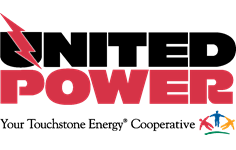United Power is committed to providing members with the tools and resources they need to take control of their energy use. As we enter a new year, it’s now easier to control your energy and become more energy efficient. Here are some ways United Power is empowering its members to take control.
Rates that Work for You
Families spent more time at home over the past two years due to the pandemic transitioning many to working from a home office while schooling from the kitchen or living room. As a result, members are more aware of the ways they use energy. Now is the time to ask your cooperative about your rate and choose one that works for you and your family. United Power’s residential rates provide individuals and families options designed to fit a variety of lifestyles. The flexibility of available rates enables members to review their energy use habits and select a plan that fits their usage patterns. The cooperative’s rates will also remain unchanged as we head into 2022.
For more information on United Power’s rates, go to the cooperative's Rates page, or to have a dedicated energy management specialist review your history and recommend a rate option, call 303-637-1311.
Take Advantage of Free Member Resources
United Power provides several programs and tools to help members understand their usage. The Power Portal is an accessory to the cooperative’s online account portal and provides detailed energy use information. With information displayed in 15-minute intervals throughout the day, members can compare days or months to determine what’s driving energy usage.
In addition to this resource, the cooperative has also launched calculators to help members understand what drives their demand or how charging an electric vehicle can impact their usage. More resources may be coming in the future, and all these tools are available free to United Power members.
‘Smart’ Way to Save on Heating this Winter
Heating and cooling your home accounts for approximately half your annual energy usage, making it the most expensive part of your energy costs. The most efficient way to manage your heating and cooling is installing a smart thermostat, which gives you control even when you’re not home. A simple adjustment to your thermostat could save you as much as 10 percent annually, according to the Department of Energy, which recommends adjusting your temperature a couple degrees when you’re home and a couple more when you’re away. Many smart thermostats can learn your schedule and make these adjustments automatically.
Talk to an Energy Management Specialist
A United Power Energy Management Specialist is available to walk through your energy concerns, analyze your usage and provide you with practical information you can use to control your energy usage. They can walk you through available rates, programs and rebates to ensure you’re maximizing your energy savings.
Ultimately, energy savings comes down to the small things. Turn off lights and ceiling fans when you aren’t in a room. Stagger the use of appliances to avoid a higher demand. Remind everyone in your family to make energy savings a priority. Enter into the new year resolved to be more energy efficient.


 At United Power we continue with our sole focus of bringing power to our members at the greatest value.
At United Power we continue with our sole focus of bringing power to our members at the greatest value.